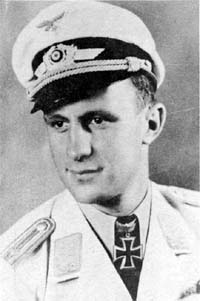Fighter aces in World War II had tremendously varying kill scores, affected as they were by many factors: the pilot's skill level, the performance of the airplane the pilot flew and the planes they flew against, how long they served, their opportunity to meet the enemy in the air (Allied to Axis disproportion), whether they were the formation's leader or a wingman, the standards their air service brought to the awarding of victory credits, et cetera.

Hans-Heinz Augenstein was a German Luftwaffe military aviator and flying ace during World War II. A flying ace or fighter ace is a military aviator credited with shooting down five or more enemy aircraft during aerial combat. Operating as a night fighter pilot, he was credited with 46 aerial victories, of which 45 were four-engine bombers, all of which claimed in Defense of the Reich.

Kurt Tanzer was a World War II Luftwaffe military aviator. As a flying ace, he is credited with approximately 128–143 aerial victories. He was a recipient of the Knight's Cross of the Iron Cross, the highest award in the military and paramilitary forces of Nazi Germany during World War II. He later joined the German Air Force and was killed in a flying accident on 25 June 1960.

Bernhard Vechtel was a fighter pilot in the Luftwaffe of Nazi Germany during World War II. He was a recipient of the Knight's Cross of the Iron Cross. Vechtel was credited with 108 aerial victories in a total of 860 combat missions, all on the Eastern Front.
Eckart-Wilhelm von Bonin was a German World War II night fighter pilot who served in the Luftwaffe. A flying ace or fighter ace is a military aviator credited with shooting down five or more enemy aircraft during aerial combat. He is credited with shooting down 37 enemy aircraft claimed during 150 combat missions.
Wilhelm Beier was a Luftwaffe night fighter ace and recipient of the Knight's Cross of the Iron Cross during World War II. The Knight's Cross of the Iron Cross was awarded to recognize extreme battlefield bravery or successful military leadership. Depending on source, Beier claimed 38 nocturnal aerial victories, including 14 of which flying intruder missions, intercepting bombers on their return flight to England.
Dr. Horst Patuschka was a Luftwaffe night fighter ace and recipient of the Knight's Cross of the Iron Cross during World War II. The Knight's Cross of the Iron Cross was awarded to recognise extreme battlefield bravery or successful military leadership. Horst Patuschka was killed on 6 March 1943 after his Junkers Ju 88 crashed near Bizerte, Tunisia due to engine failure. During his career he was credited with 23 aerial victories all of them at night. He was posthumously awarded the Knight's Cross on 10 May 1943.
Lothar Linke was a German Luftwaffe night fighter pilot and recipient of the Knight's Cross of the Iron Cross during World War II. Linke claimed 27 aerial victories, 24 of them at night. On 14 May 1943 Linke and his crew were forced to bail out after engine failure of their Messerschmitt Bf 110. He struck the tail end of the plane and was killed. On 19 September 1943, he was posthumously awarded the Knight's Cross.
Paul Szameitat was a German Luftwaffe night fighter ace and recipient of the Knight's Cross of the Iron Cross during World War II. The Knight's Cross of the Iron Cross was awarded to recognise extreme battlefield bravery or successful military leadership. Szameitat claimed 29 victories, 28 at night.
Heinz-Horst Hißbach was a Luftwaffe night fighter ace and recipient of the Knight's Cross of the Iron Cross during World War II. The Knight's Cross of the Iron Cross was awarded to recognise extreme battlefield bravery or successful military leadership. Heinz-Horst Hißbach claimed 27 aerial victories, 22 of them at night.
Werner Husemann was a German Luftwaffe night fighter ace and recipient of the Knight's Cross of the Iron Cross, the highest award in the military and paramilitary forces of Nazi Germany during World War II. Husemann claimed to have shot down 34 enemy aircraft, and was credited with 30 aerial victories.